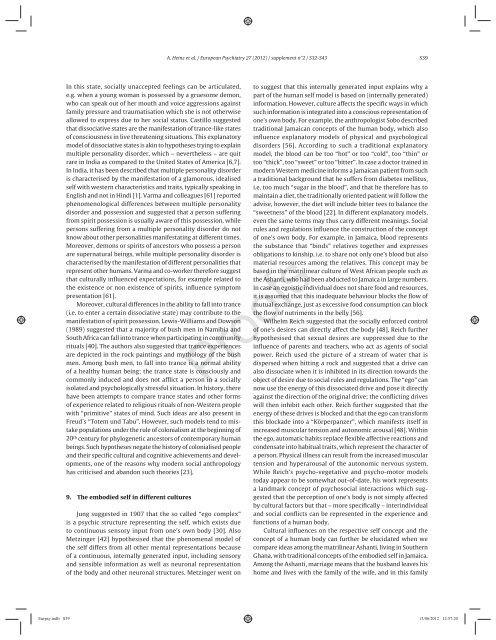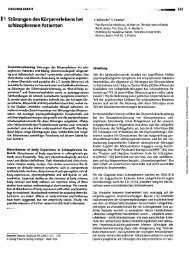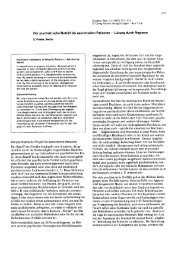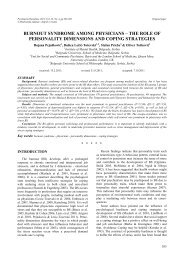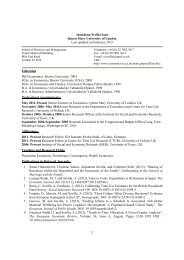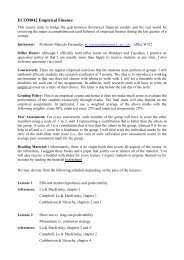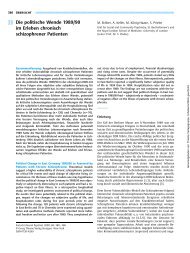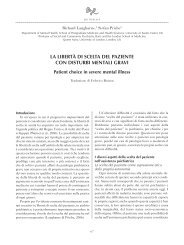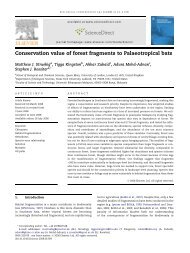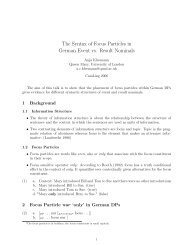Proofs - Personal Webspace for QMUL - Queen Mary, University of ...
Proofs - Personal Webspace for QMUL - Queen Mary, University of ...
Proofs - Personal Webspace for QMUL - Queen Mary, University of ...
Create successful ePaper yourself
Turn your PDF publications into a flip-book with our unique Google optimized e-Paper software.
In this state, socially unaccepted feelings can be articulated,<br />
e.g. when a young woman is possessed by a gruesome demon,<br />
who can speak out <strong>of</strong> her mouth and voice aggressions against<br />
family pressure and traumatisation which she is not otherwise<br />
allowed to express due to her social status. Castillo suggested<br />
that dissociative states are the manifestation <strong>of</strong> trance- like states<br />
<strong>of</strong> consciousness in live threatening situations. This explanatory<br />
model <strong>of</strong> dissociative states is akin to hypotheses trying to explain<br />
multiple personality disorder, which – nevertheless – are quit<br />
rare in India as compared to the United States <strong>of</strong> America [6,7].<br />
In India, it has been described that multiple personality disorder<br />
is characterised by the manifestation <strong>of</strong> a glamorous, idealised<br />
self with western characteristics and traits, typically speaking in<br />
English and not in Hindi [1]. Varma and colleagues [61] reported<br />
phenomenological differences between multiple personality<br />
disorder and possession and suggested that a person suffering<br />
from spirit possession is usually aware <strong>of</strong> this possession, while<br />
persons suffering from a multiple personality disorder do not<br />
know about other personalities manifestating at different times.<br />
Moreover, demons or spirits <strong>of</strong> ancestors who possess a person<br />
are supernatural beings, while multiple personality disorder is<br />
characterised by the manifestation <strong>of</strong> different personalities that<br />
represent other humans. Varma and co- worker there<strong>for</strong>e suggest<br />
that culturally infl uenced expectations, <strong>for</strong> example related to<br />
the existence or non existence <strong>of</strong> spirits, infl uence symptom<br />
presentation [61].<br />
Moreover, cultural differences in the ability to fall into trance<br />
(i.e. to enter a certain dissociative state) may contribute to the<br />
manifestation <strong>of</strong> spirit possession. Lewis- Williams and Dowson<br />
(1989) suggested that a majority <strong>of</strong> bush men in Namibia and<br />
South Africa can fall into trance when participating in community<br />
rituals [40]. The authors also suggested that trance experiences<br />
are depicted in the rock paintings and mythology <strong>of</strong> the bush<br />
men. Among bush men, to fall into trance is a normal ability<br />
<strong>of</strong> a healthy human being; the trance state is consciously and<br />
commonly induced and does not affl ict a person in a socially<br />
isolated and psychologically stressful situation. In history, there<br />
have been attempts to compare trance states and other <strong>for</strong>ms<br />
<strong>of</strong> experience related to religious rituals <strong>of</strong> non- Western people<br />
with “primitive” states <strong>of</strong> mind. Such ideas are also present in<br />
Freud´s “Totem und Tabu”. However, such models tend to mistake<br />
populations under the rule <strong>of</strong> colonialism at the beginning <strong>of</strong><br />
20th century <strong>for</strong> phylogenetic ancestors <strong>of</strong> contemporary human<br />
beings. Such hypotheses negate the history <strong>of</strong> colonialised people<br />
and their specifi c cultural and cognitive achievements and developments,<br />
one <strong>of</strong> the reasons why modern social anthropology<br />
has criticised and abandon such theories [23].<br />
9. The embodied self in different cultures<br />
Jung suggested in 1907 that the so called “ego complex”<br />
is a psychic structure representing the self, which exists due<br />
to continuous sensory input from one’s own body [30]. Also<br />
Metzinger [42] hypothesised that the phenomenal model <strong>of</strong><br />
the self differs from all other mental representations because<br />
<strong>of</strong> a continuous, internally generated input, including sensory<br />
and sensible in<strong>for</strong>mation as well as neuronal representation<br />
<strong>of</strong> the body and other neuronal structures. Metzinger went on<br />
A. Heinz et al. / European Psychiatry 27 (2012) / supplement n°2 / S32-S43 S39<br />
to suggest that this internally generated input explains why a<br />
part <strong>of</strong> the human self model is based on (internally generated)<br />
in<strong>for</strong>mation. However, culture affects the specifi c ways in which<br />
such in<strong>for</strong>mation is integrated into a conscious representation <strong>of</strong><br />
one’s own body. For example, the anthropologist Sobo described<br />
traditional Jamaican concepts <strong>of</strong> the human body, which also<br />
infl uence explanatory models <strong>of</strong> physical and psychological<br />
disorders [56]. According to such a traditional explanatory<br />
model, the blood can be too “hot” or too “cold”, too “thin” or<br />
too “thick”, too “sweet” or too “bitter”. In case a doctor trained in<br />
modern Western medicine in<strong>for</strong>ms a Jamaican patient from such<br />
a traditional background that he suffers from diabetes mellitus,<br />
i.e. too much “sugar in the blood”, and that he there<strong>for</strong>e has to<br />
maintain a diet, the traditionally oriented patient will follow the<br />
advise, however, the diet will include bitter tees to balance the<br />
“sweetness” <strong>of</strong> the blood [22]. In different explanatory models,<br />
even the same terms may thus carry different meanings. Social<br />
rules and regulations infl uence the construction <strong>of</strong> the concept<br />
<strong>of</strong> one’s own body. For example, in Jamaica, blood represents<br />
the substance that “binds” relatives together and expresses<br />
obligations to kinship, i.e. to share not only one’s blood but also<br />
material resources among the relatives. This concept may be<br />
based in the matrilinear culture <strong>of</strong> West African people such as<br />
the Ashanti, who had been abducted to Jamaica in large numbers.<br />
In case an egoistic individual does not share food and resources,<br />
it is assumed that this inadequate behaviour blocks the fl ow <strong>of</strong><br />
mutual exchange, just as excessive food consumption can block<br />
the fl ow <strong>of</strong> nutriments in the belly [56].<br />
Wilhelm Reich suggested that the socially en<strong>for</strong>ced control<br />
<strong>of</strong> one’s desires can directly affect the body [48]. Reich further<br />
hypothesised that sexual desires are suppressed due to the<br />
infl uence <strong>of</strong> parents and teachers, who act as agents <strong>of</strong> social<br />
power. Reich used the picture <strong>of</strong> a stream <strong>of</strong> water that is<br />
dispersed when hitting a rock and suggested that a drive can<br />
also dissociate when it is inhibited in its direction towards the<br />
object <strong>of</strong> desire due to social rules and regulations. The “ego” can<br />
now use the energy <strong>of</strong> this dissociated drive and pose it directly<br />
against the direction <strong>of</strong> the original drive; the confl icting drives<br />
will then inhibit each other. Reich further suggested that the<br />
energy <strong>of</strong> these drives is blocked and that the ego can trans<strong>for</strong>m<br />
this blockade into a “Körperpanzer”, which manifests itself in<br />
increased muscular tension and autonomic arousal [48]. Within<br />
the ego, automatic habits replace fl exible affective reactions and<br />
condensate into habitual traits, which represent the character <strong>of</strong><br />
a person. Physical illness can result from the increased muscular<br />
tension and hyperarousal <strong>of</strong> the autonomic nervous system.<br />
While Reich’s psycho- vegetative and psycho- motor models<br />
today appear to be somewhat out- <strong>of</strong>- date, his work represents<br />
a landmark concept <strong>of</strong> psychosocial interactions which suggested<br />
that the perception <strong>of</strong> one’s body is not simply affected<br />
by cultural factors but that – more specifi cally – interindividual<br />
and social confl icts can be represented in the experience and<br />
functions <strong>of</strong> a human body.<br />
Cultural infl uences on the respective self concept and the<br />
concept <strong>of</strong> a human body can further be elucidated when we<br />
compare ideas among the matrilinear Ashanti, living in Southern<br />
Ghana, with traditional concepts <strong>of</strong> the embodied self in Jamaica.<br />
Among the Ashanti, marriage means that the husband leaves his<br />
home and lives with the family <strong>of</strong> the wife, and in this family<br />
<strong>Pro<strong>of</strong>s</strong>


